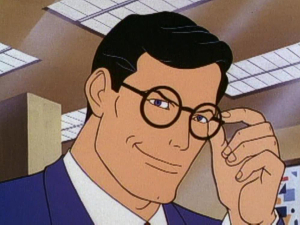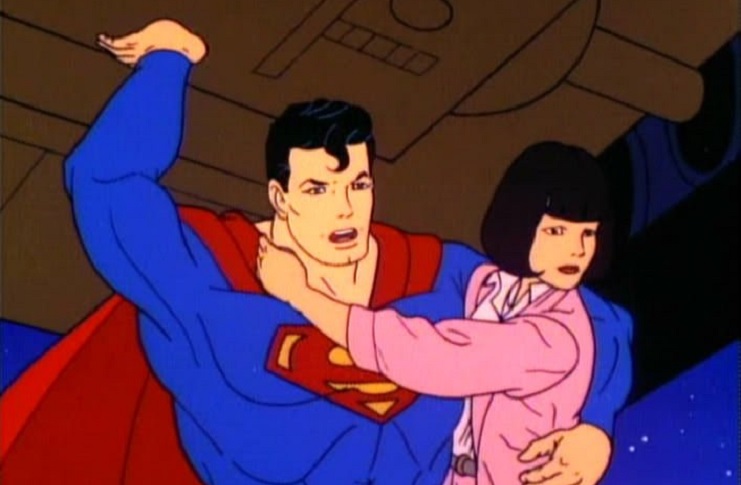
I didn’t set out to devote a series to the creations of Ruby-Spears Productions. But while I wanted to cover The Plastic Man Comedy/Adventure Show, I needed to cover Fangface first. And then when trying to come up with an idea for this week’s subject, I came across the Ruby-Spears Superman cartoon from the late 1980s, a short-lived program that was high in quality and kind of historically significant. So here we are.
Superman had previously been animated in still-beloved theatrical shorts by Fleischer Studios in the 1940s. The New Adventures of Superman was one of the first original Saturday morning cartoons in 1967. For a decade, he was one of the main characters (some would argue, THE MAIN character) on Hanna-Barbera and ABC’s Super Friends that began in 1973. When Super Friends ended in 1986, it left a huge void as no other superhero cartoons were on the air on any network.
(Okay, you could argue that syndicated afternoon shows like Masters of the Universe and Thundercats were kind of superhero shows, but we’re talking straightforward comic book types.)
But the Man of Steel would return to animation in 1988, courtesy of Ruby-Spears. This cartoon, called Superman, was intentionally launched this year as it was the character’s 50th anniversary. Simultaneously, a syndicated live-action Superboy series was kicked off and CBS aired a Superman 50th Anniversary special in May of that same year.
It’s also particularly timely that Ruby-Spears’ Superman launched in 1988 for another reason connected to comic book history. Filmation’s Superman, which launched in 1967, reflected the Silver Age of comics. Super Friends began in 1973, firmly in the comics’ Bronze Age.
By the 1980s, comics had seemingly entered a new “Age,” but it has no official name. A major change was that kids had stopped growing out of comic books. Teens and adults kept reading and collecting them. As a result, the writing and art became more mature and higher in quality.
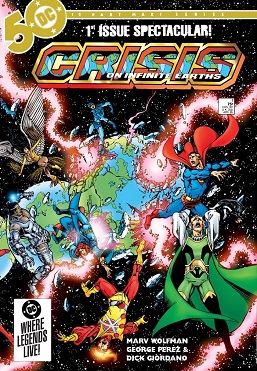
In the early 1980s, with DC’s 50th anniversary looming, the publisher started developing its most massive comic book event to date, Crisis on Infinite Earths. Marv Wolfman wrote the story and George Pérez illustrated it. This dynamic duo had already delivered DC’s top-selling book at the time, The New Teen Titans. The series brought together nearly every character that had ever appeared in a DC book and, in the end, rebooted the entire continuity, streamlining it, eliminating multiple versions of many characters, and getting rid of its multiverse.
As part of Phase #2, DC wanted to overhaul its flagship heroes, Batman, Wonder Woman, and Superman, making them more unique and appealing to a new generation and to the older readers that were making up more and more of its audience. In order to do this, DC turned to some of the biggest names in the field, with Frank Miller largely overseeing Batman’s reinvention, George Pérez tackling Wonder Woman, and John Byrne, a longtime Marvel writer/artist, retooling Superman.
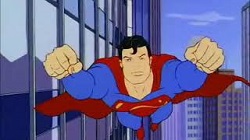
Ruby-Spears’ Superman cartoon reflected Byrne’s new update. So while Super Friends depicted the pre-Crisis era, its cancellation and the launch of the RS Superman coincided with the rapid evolution of DC Comics of the time.
John Byrne drew heavy inspiration from the 1978 Superman movie directed by Richard Donner and starring Christopher Reeve. Byrne and DC essentially scrapped all of Superman’s history and started from scratch. Clark Kent/Kal-El had never become Superboy (much less Superbaby!) and, similar to Reeve’s take, launched his crimefighting career as an adult.
Lex Luthor was no longer a mad scientist whose entire vendetta against the Man of Steel was fueled by the fact that Superboy had accidentally caused him to lose his hair. Instead, he was a wealthy industrialist who, to the general public, was an upstanding citizen (similar to Gene Hackman’s depiction in the film). Like many ’80s businessmen, he was shady as hell but had the political power and money to cover up his nefarious deeds. (Also, like a certain shady businessman from the comics of the era, Lex later became President.)
Fittingly, this Superman cartoon employed the John Williams theme music from the movies.
One change in the comics that was not reflected in the show is that Lois Lane’s hair was changed from black to brown. But she had black hair in the cartoon. She was given a then-chic blunt bob style.
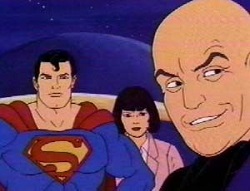
One of the biggest changes Byrne wrought was establishing that Clark’s human parents, Jonathan and Martha Kent were still alive! In every previous comic book, they died and that’s when Clark became Superman and moved to Metropolis to begin his career as a journalist and as Superman.
Instead, on Superman, like in the comics, they became regular supporting characters that kept Clark grounded and connected to his humanity.
On RS’s Superman, there was even a four-minute segment at the end of each episode, called “Superman Family Album” which depicted Clark at various ages, from a young child to a teen, growing up in Smallville, with the Kents playing major roles. They appeared in the main episodes as well.
Jimmy Olsen and Perry White were also major supporting characters.
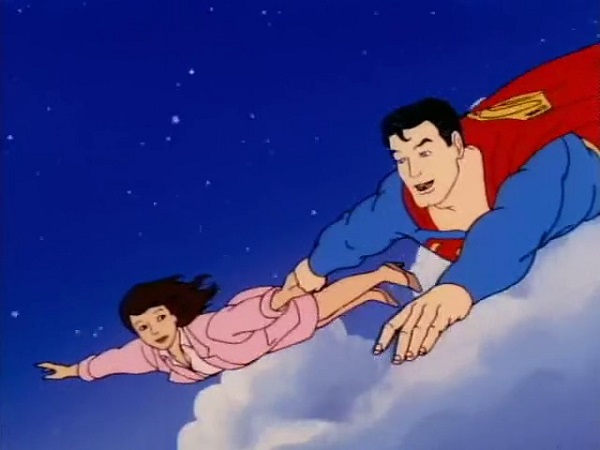
Beau Weaver voiced Superman/Clark Kent, with Ginny McSwain as Lois (McSwain also served as the show’s voice director), Michael Bell as Lex Luthor, Tress MacNeille as Martha Kent, Alan Oppenheimer as Jonathan Kent, Stanley Ralph Ross as Perry White, Lynne Marie Stewart as Young Clark Kent, and Mark Taylor as Jimmy Olsen. Bill Woodson, who narrated Super Friends, also narrated the opening of each episode, using an abridged version of the script from the 1950s live-action series The Adventures of Superman, which starred George Reeves.
“Faster than a speeding bullet. More powerful than a locomotive. Able to leap tall buildings in a single bound. Superman! Yes, Superman – strange visitor from another planet who came to Earth with powers and abilities far beyond those of mortal men. Superman – who disguised as Clark Kent, mild-mannered reporter for a great metropolitan newspaper, fights a neverending battle for Truth, Justice, and the American Way.”
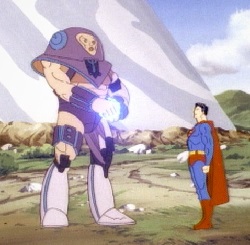
Because this series arrived shortly after Byrne had relaunched the comics, some characters were depicted in a more old school style including the Kryptonian villains General Zod (René Auberjonois), Ursa, and Faora (both voiced by McSwain).
Byrne had not yet come up with an approach for Brainiac, so a new similar character named Cybron was introduced. Originally, Brainiac looked like a human with green skin. In the early ’80s, he was completely overhauled (by Pérez) as a skeletal silver robot with an exposed electronic brain. (This version appeared in the second-to-last season of Super Friends.) Cybron, however, was depicted as a towering behemoth.
Other villains reflected Byrne’s usage in the current comics, and there were also some completely original foes.
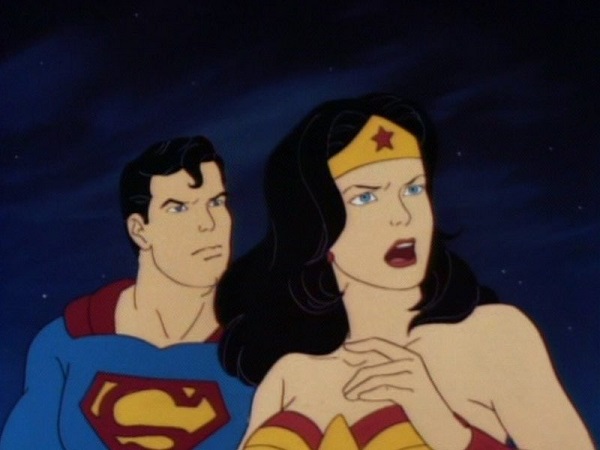
Perhaps the biggest highlight of Superman was the eighth episode, “Superman and Wonder Woman vs. the Sorceress of Time.” As you can tell by the title, the episode featured a guest appearance from Wonder Woman. She was the only other DC hero to pop up in this series.
Wonder Woman had co-starred with the Man of Steel on every iteration of Super Friends, but that was during the pre-Crisis version. This was the post-Crisis version, mostly reflecting Pérez’s reboot. Most noticeably, she could fly. However, this version had blue wristbands, the way she was depicted pre-Crisis. One of the changes Pérez introduced was giving Diana silver wristbands, perhaps differentiating her from her Amazon sisters.
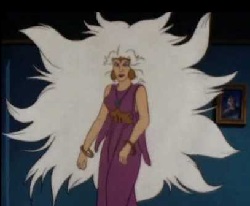
Wonder Woman was voiced by Mary McDonald-Lewis, who McSwain had originally championed to play Lois before RS chose to play Lois. But interestingly, in the “Sorceress of Time,” Syrene was voiced by B.J. Ward, who had voiced Wonder Woman on The Super Powers Team: Galactic Guardians.
Also coincidentally, McDonald-Lewis voiced Lois Lane on the penultimate season, Super Friends: The Legendary Super Powers Show. There were many other actors on Superman that had also contributed to Super Friends, but these seemed like particularly interesting castings.
Superman appeared again in 1988, as Saturday morning cartoons were waning on the three original networks, ABC, CBS, and NBC. And perhaps old-school comic book superheroes were no longer appealing to young audiences. It only lasted for one 13-episode season. Unlike Super Friends, which was ABC’s flagship Saturday a.m. series for close to a decade, Superman aired on CBS. Marv Wolfman and fellow comic book writer Steve Gerber wrote for the series. Wolfman acted as showrunner. Despite the show being based on Byrne’s work, artist Gil Kane worked on the art side of this show.
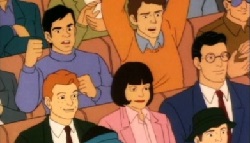
If you want to check out this series, it was released on DVD in 2009. Digital episodes can be purchased for $1.99 each from various outlets, although it should surface on HBO Max at some point.
Superman (1988) is an interesting show in that it feels almost like reading a post-Crisis comic book right after Crisis on Infinite Earths. There are changes, but the tone isn’t terribly different. In a sense, this feels like a spiritual successor to Super Friends before DC cartoons received a MAJOR overhaul just a few years later with Batman: The Animated Series, which of course led to Superman: The Animated Series.
Are you familiar with the ’80s Superman cartoon? If so, how does it measure up to other animated takes on the character?
